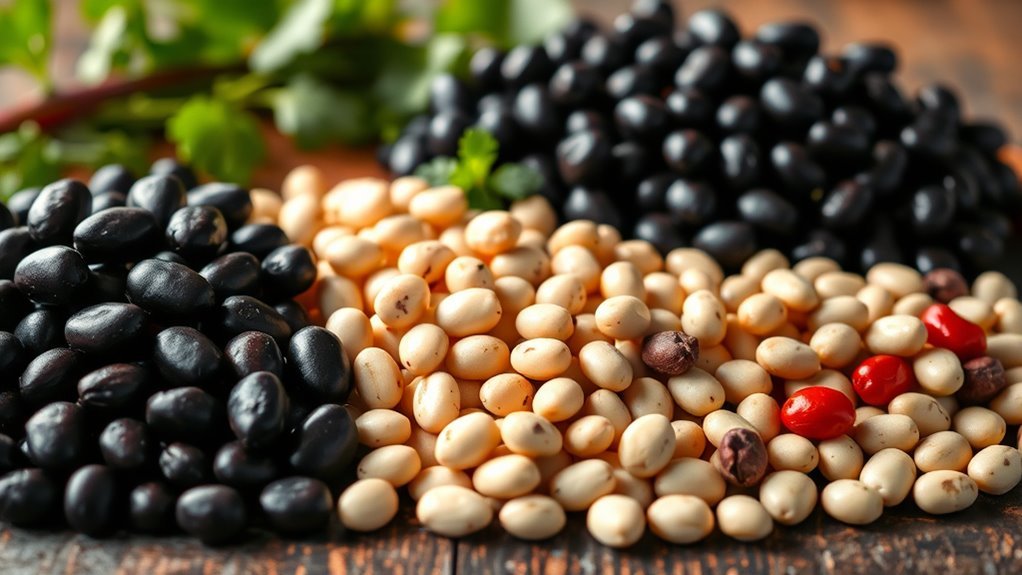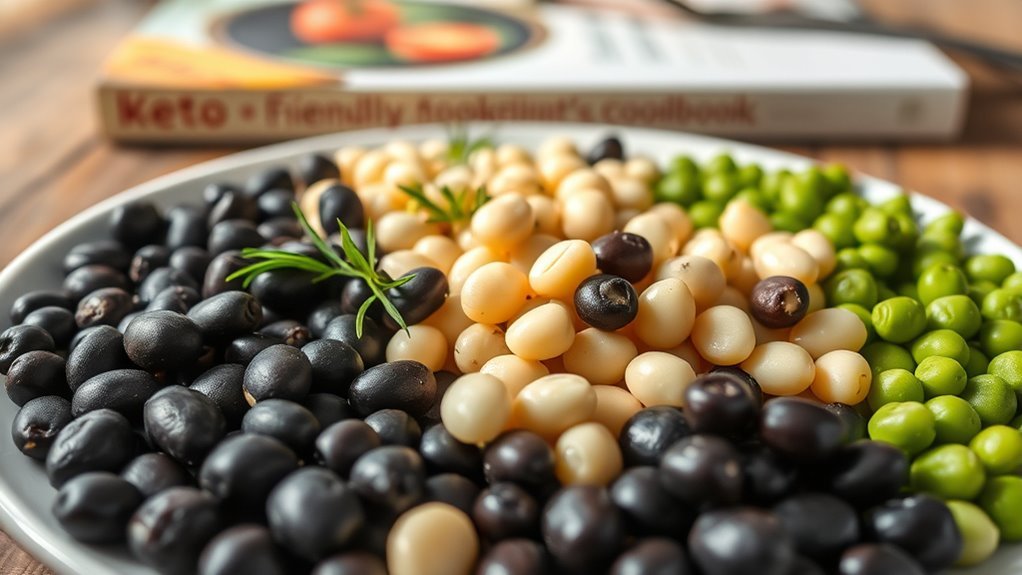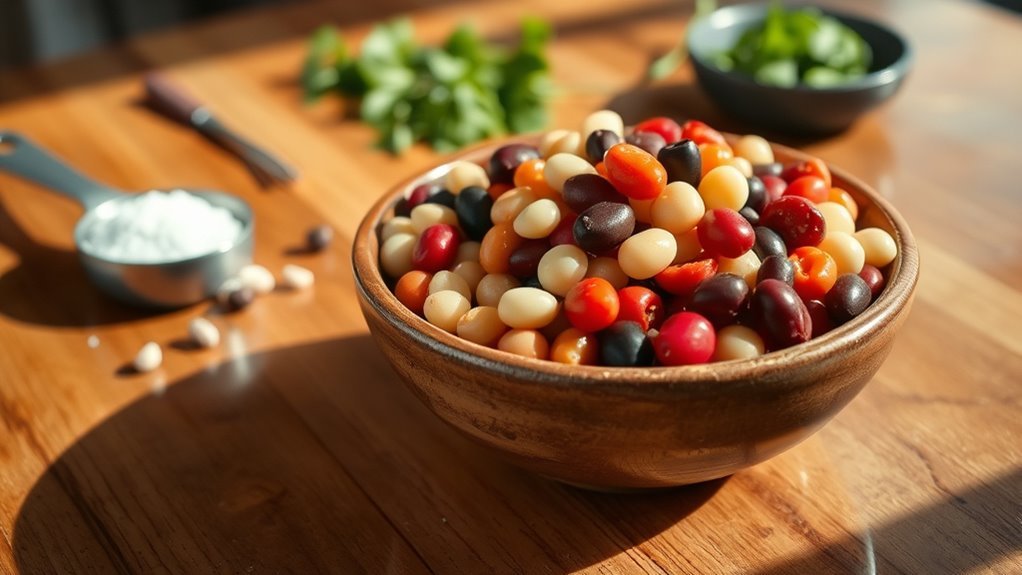You can eat beans on a ketogenic diet, but you need to be cautious about their carbohydrate content. Most beans are high in carbs, which can affect your ketosis. However, you might enjoy small portions of lower-carb options like black soybeans or green beans, and incorporating them with high-fat foods can help balance your meals. Keeping portion sizes in check is essential. Discover more about how to effectively include beans in your keto meals for the best results.
Understanding the Ketogenic Diet

While you may have heard a lot about the ketogenic diet, it’s essential to understand its core principles to make informed food choices. The keto basics revolve around a high-fat, moderate-protein, and very low-carbohydrate intake. This shift in macronutrient ratios encourages your body to enter a state of ketosis, where fat becomes the primary fuel source instead of carbohydrates. Diet essentials include focusing on healthy fats, such as avocados and olive oil, while minimizing sugars and starches. It’s vital to choose whole, unprocessed foods to optimize your health on this diet. By grasping these principles, you can navigate your food choices more freely, ensuring you stay aligned with your health goals while enjoying the journey of nutritional exploration.
Nutritional Profile of Beans

Beans are often celebrated for their rich nutritional profile, making them a staple in many diets. Their impressive bean nutrition includes not only a good amount of fiber but also a notable protein content, which can be quite appealing. If you’re curious about how beans stack up, here’s a quick comparison:
| Nutrient | Amount per 100g |
|---|---|
| Protein | 8.5g |
| Fiber | 6.4g |
| Carbohydrates | 27g |
| Fat | 0.8g |
Including beans in your meals can contribute to a balanced diet. However, it is important to take into account your overall carbohydrate intake, especially on a keto plan. Enjoy the benefits of beans while staying mindful of your dietary goals.
Types of Beans and Their Carbohydrate Content

When considering a keto diet, it is essential to know that different types of beans vary considerably in their carbohydrate content. For instance, black beans contain around 20 grams of carbs per cup, while kidney beans have about 22 grams. Pinto beans and navy beans are similarly high at roughly 25 grams each. Chickpeas nutrition shows about 27 grams of carbs per cup, making them less suitable for keto. When doing a carbohydrate comparison, you’ll find that these bean varieties also offer good protein content and fiber amount, which can be beneficial in moderation. Cooking methods can also affect their carb levels; for example, canned beans may contain added sugars. Always check labels to stay informed.
The Role of Fiber in a Ketogenic Diet
When you’re on a ketogenic diet, understanding the role of dietary fiber is essential for your overall health. There are different types of fiber, each playing a unique role in digestion and nutrient absorption, which can impact your experience on keto. Not only does fiber help regulate blood sugar levels, but it can also aid in maintaining gut health, making it an important consideration when choosing what to eat.
Importance of Dietary Fiber
Dietary fiber plays an essential role in maintaining digestive health, especially on a ketogenic diet. While many might think of fiber as something only found in grains or fruits, there are plenty of fiber sources compatible with keto. Including adequate fiber is vital to prevent constipation and promote overall gut health. Here are some key benefits of fiber on your keto journey:
- Supports regular bowel movements
- Helps maintain healthy cholesterol levels
- Aids in blood sugar regulation
- Promotes feelings of fullness, reducing cravings
Incorporating low-carb, fiber-rich foods can help you enjoy the freedom of a ketogenic lifestyle while still prioritizing your digestive health. So, don’t overlook the power of fiber as you navigate your dietary choices!
Fiber Types Explained
Understanding the different types of fiber can enhance your approach to a ketogenic diet. There are two main categories: soluble fiber and insoluble fiber. Soluble fiber dissolves in water and can help regulate blood sugar levels, making it beneficial for those on keto. It’s found in foods like avocados and chia seeds. On the other hand, insoluble fiber doesn’t dissolve and aids in digestion, promoting regularity. Foods rich in insoluble fiber include leafy greens and nuts, which can fit well into your meal plans. Both types play essential roles in your overall health, especially when you’re limiting carbs. By knowing how each type functions, you can make informed choices that align with your dietary goals.
Fiber’s Impact on Keto
While you might think of fiber as just a means to support digestion, its impact on a ketogenic diet goes far beyond that. Fiber plays a vital role in your keto adaptation, helping to maintain digestive health while you shift your body into ketosis. Here’s how fiber can influence your keto journey:
- Supports digestion: Promotes regular bowel movements and can reduce constipation.
- Aids in satiety: Helps you feel full longer, which can prevent overeating.
- Stabilizes blood sugar: Slows down carbohydrate absorption, minimizing insulin spikes.
- Enhances gut health: Fuels beneficial gut bacteria, supporting overall health.
Incorporating fiber into your keto diet can make the change smoother and more enjoyable, allowing you the freedom to thrive on this lifestyle.
Low-Carb Bean Alternatives
If you’re looking for low-carb alternatives to beans on a ketogenic diet, consider options like cauliflower and zucchini noodles. Cauliflower can mimic the texture of beans in dishes, while zucchini noodles offer a satisfying base for your meals without the extra carbs. Additionally, chia seeds can provide a nutritious, fiber-rich option that helps keep you full and supports your overall health.
Cauliflower as Substitute
Although beans are often a staple in many diets, those following a ketogenic lifestyle may need to seek alternatives due to their higher carbohydrate content. Cauliflower is an excellent substitute that can mimic the texture of beans while keeping your carb intake low. Here are some creative ways to incorporate cauliflower into your meals:
- Cauliflower rice: Use it as a base for stir-fries or salads.
- Cauliflower mash: A creamy alternative to mashed potatoes, perfect as a side dish.
- Cauliflower tacos: Chop and season it for a filling in lettuce wraps.
- Cauliflower hummus: Blend cooked cauliflower with tahini and spices for a tasty dip.
These options allow you to enjoy delicious flavors without sacrificing your keto goals.
Zucchini Noodles Benefits
Zucchini noodles, often referred to as “zoodles,” offer a fantastic low-carb alternative to traditional pasta, making them an excellent choice for those on a ketogenic diet. With only about 20 calories and 4 grams of carbs per cup, zucchini noodles nutrition is impressive, allowing you to enjoy a satisfying meal without the carb overload. They’re also rich in vitamins A and C, providing essential nutrients while keeping your macros in check. You can whip up a variety of zucchini noodles recipes, from spicy stir-fries to creamy Alfredo dishes, ensuring you never feel deprived on your keto journey. Plus, their mild flavor pairs well with countless sauces, spices, and proteins, giving you the freedom to explore delicious, guilt-free meals.
Chia Seed Options
While beans are often considered a healthy source of protein and fiber, their higher carbohydrate content can make them less suitable for a ketogenic diet. Fortunately, chia seeds offer a low-carb alternative packed with nutrients. Here are some chia seed benefits you’ll love:
- High in Fiber: Supports digestive health and keeps you feeling full.
- Rich in Omega-3s: Promotes heart health and reduces inflammation.
- Low in Carbs: Perfect for a keto lifestyle, keeping your carb intake in check.
- Versatile: Great in smoothies, puddings, or baked goods—try various chia seed recipes!
Incorporating chia seeds into your meals not only satisfies your hunger but also keeps you aligned with your keto goals. Enjoy the freedom of flavorful, healthy eating!
Ways to Incorporate Beans Into Keto Meals
If you’re wondering how to enjoy beans while sticking to a keto diet, there are several creative ways to incorporate them into your meals without exceeding your carb limits. One option is to make bean salads using small portions of black or kidney beans, mixed with low-carb veggies like cucumbers and bell peppers. This adds flavor and texture while keeping carb counts manageable. Another delicious option is to prepare bean dips, such as a black bean salsa or a white bean hummus, using just a small amount of beans combined with olive oil and spices. These dips can be enjoyed with keto-friendly vegetables for a satisfying snack. By being mindful of portion sizes, you can enjoy the benefits of beans on your keto journey.
The Impact of Beans on Ketosis
Beans can markedly impact your state of ketosis, primarily due to their carbohydrate content. While they’re nutritious, you’ll need to be cautious about your carb limits if you want to maintain ketosis. Here’s what to take into account:
Beans can affect ketosis due to their carbohydrate content, so monitor your intake carefully.
- High Carb Content: Most beans contain significant carbs, which can kick you out of ketosis.
- Fiber Benefits: Beans are high in fiber, which may help with digestion but still counts toward your carb total.
- Nutritional Value: They’re packed with protein and micronutrients, making them a balanced food choice.
- Individual Variation: Everyone’s body reacts differently; some may tolerate small amounts without disrupting ketosis.
Portion Control and Serving Suggestions
Although you might be tempted to include beans in your keto diet due to their nutritional benefits, portion control is essential to prevent exceeding your carbohydrate limits. Generally, it’s best to keep your portion sizes small—aim for about ¼ cup cooked beans in a meal. This allows you to enjoy their fiber and protein without derailing your keto goals.
For meal combinations, consider pairing beans with high-fat foods like avocado or cheese, which can help balance your macronutrient intake. You can also incorporate them into salads or soups, where a little goes a long way. By being mindful of portion sizes, you can enjoy the benefits of beans while maintaining your keto lifestyle without feeling restricted.
Personalizing Your Keto Diet With Beans
While integrating beans into your keto diet may seem challenging due to their carbohydrate content, personalizing your approach can make it both feasible and enjoyable. Start by considering your personal preferences and how beans can fit into your meal planning. Here are some strategies:
- Choose lower-carb beans like black soybeans or green beans.
- Incorporate beans in moderation, adjusting portions to meet your carb limits.
- Combine beans with high-fat ingredients, such as olive oil or avocado, to balance your meals.
- Experiment with recipes that highlight beans, ensuring they complement your overall keto goals.


